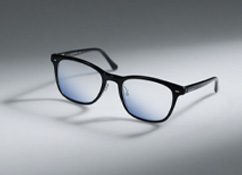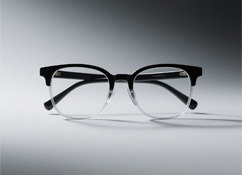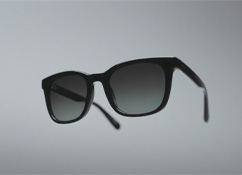The Pupil of Code: A Sci-Fi Thriller of Glasses, Legacy, and Digital Warfare
When Seattle’s acid rain streaked Amazon HQ’s glass dome with thick watermarks, Jack Cole wiped his titanium-framed glasses on his sleeve. Duct tape wrapped around the temple had yellowed, and three scratches on the right lens crawled across his field of vision like centipedes—permanent scars from a laser burn during last year’s quantum server calibration. On rainy days, the ache behind the lens throbbed like a pinprick.
“Typical MIT dropout—look like you can’t afford a decent meal?” Walker, the tech director, ground his alligator loafers over Jack’s data cable, slamming half a Frappuccino onto the keyboard. Caramel syrup seeped between the keys, blooming brown stains across the screen. The open office erupted in laughter; someone yelled “System bug alert!” in programmer slang. Jack’s fists clenched, trembling slightly in the pockets of his lab coat.
The Glasses: A Grandfather’s Legacy
These glasses were the last thing his grandfather had pressed into his hand. The old engineer, who’d worked on early ARPANET development, had etched Morse code into the frame’s inner side before Alzheimer’s fully took hold. It had taken Jack three months to decode it: a line from Blade Runner. He’d never grasped the point of this hunk of scrap metal—until last night, while sorting through his grandfather’s things. Tucked inside TCP/IP Illustrated was a circuit diagram, and scrawled inside the hollow temple: “Micro Quantum Processor.”
Red Alert: The Digital Crisis Unfolds
At 2:17 a.m., red light from the data center suddenly swallowed the building.
“All payment interfaces just crashed!” An intern’s scream shattered the silence. On the monitors, the lockout progress bar for the Federal Reserve’s digital currency vault climbed 12% per second. Wall Street’s screens blared alarms; the Dow Jones curve plummeted like a slashed artery, each flickering number bleeding billions in value by the second.
Walker’s roar exploded over the intercom: “Cole! You maintained that firewall—get to the server room! Fix this by dawn, or the FBI’ll have you sipping coffee at Quantico for life!”
Decoding the Enemy: The Glasses Activate
Jack burst into the server room, and the glasses suddenly buzzed. The right lens clouded with a cobalt glow; the chip inside the frame burned hot. The Morse code his grandfather had etched unfurled into a 3D stream of code across his vision. Algorithms older than C by thirty years wriggled like living things, stripping the firewall’s architecture down to a transparent crystal maze—and on the seventh routing protocol node, he spotted a searing red marker. The author’s signature, “W. Walker,” flickered with the data flow.
“Need admin access to rewrite the routing table,” Jack said into the intercom, fingers flying over a virtual keyboard. The glasses pulled up the firewall’s blueprints; the “emergency backdoor” Walker had made him add last year gaped like an open safe—and the virus had slithered right through.
“An intern’s asking about access?” Walker’s laugh reeked of whiskey. “I sent security to the server room. Pray you’re out before they break your legs.”
Turning the Tables: A Grandfather’s Wisdom
Jack ripped off the intercom and tossed it. The lens flicked to thermal imaging; the main control’s physical address glowed—disguised as an AC duct, only his grandfather’s algorithms could bypass the fingerprint lock. Crawling along the fiber-optic trough, the glasses mapped the virus’s spread. Half-century-old code surged through the wires, shattering the virus’s encryption shell in the virtual void. In that moment, Jack heard his grandfather’s voice in memory: “True defense? Turn the attack into your weapon.”
Dawn Breaks: The Truth Uncovered
When sunlight finally pierced the clouds, Wall Street’s screens flashed green. As the Fed chair loosened his tie on live TV, Jack took off his glasses to wipe away fog—only to find Walker and security at the server room door. Vomit stains still marred Walker’s Armani suit; his pupils dilated in shock. On the monitors, the virus’s source code hung as a hologram, with “Walker’s Private Wallet: Swiss Bank ×××” scrolling across transfers at ten per second.
“Frame job!” Walker lunged for the glasses, but Jack dodged. The lens projected surveillance footage: Walker in the server room at midnight, the glasses’ hidden camera catching his hand plugging in a USB drive—activated automatically last night.
Legacy Continues: The Pupil of Code
As the glass door slid open, Jack caught a familiar cologne. Bill Gates stood with a Surface, FBI agents behind him holstering cuffs. “Found 12,000 Bitcoin in a Swiss account. Timestamps match the virus exactly.” His gaze fell on the glasses. “This is ‘Silver Wing’? He mentioned it in an MIT lecture twenty years ago—said it could see through code’s lies.”
Three months later, ozone hung in the Palo Alto lab. Jack adjusted new glasses: titanium frames housing his grandfather’s hand-soldered ARPANET prototype chip. Amazon’s eight-figure stock options sat in his account, but he cared more about the new lens feature—quantum entanglement detection, predicting system crashes, built from his grandfather’s notes.
A flea market vendor waited at the door with a blockchain hard drive, offering his entire NFT collection for “lenses that see metaverse bugs.” Jack put on the glasses and looked out. Silicon Valley’s data streams bloomed into a galaxy; SpaceX’s starship, guided by his collision-avoidance code, sliced through space junk above the Karman line, trailing blue fire.
The chip inside the frame warmed faintly, a star crossing half a century. Jack finally understood: his grandfather hadn’t left just glasses. He’d left a key—to every door locked by lies.











